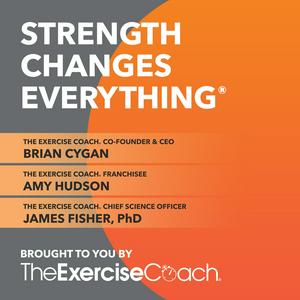268 afleveringen

5 Mindset Shifts to Crush Your Fitness Resolutions in 2026
06-1-2026 | 20 Min.
Before you set another fitness goal this year, there's something you need to rethink. Amy Hudson and Dr. James Fisher are here to wish you a happy new year and kick off 2026 with a fresh, grounded perspective on health and exercise. In this episode, they cover five mindset shifts to help you enjoy workouts, focus on real results, and create habits that actually last. If you're ready to let go of what hasn't worked and start 2026 with clarity, confidence, and a healthier relationship with movement, this episode is your invitation to do exactly that. Make 2026 your healthiest year yet! Amy shares why New Year's exercise resolutions often feel motivating at first and discouraging by February. Many goals are built around outcomes instead of behaviors. This episode helps you rethink your approach so your plan actually fits real life. Shift #1: Process versus outcome. According to Dr. Fisher, goals don't have to be about a number or a finish line. They can be about committing to the actions you repeat each week. Amy explains why changing the process is what creates long-term success. Daily habits compound in ways one perfect result never can. People who make progress are the ones who keep doing the basics consistently. Shift #2: Exercise as enjoyment, not punishment. Amy shares why enjoying your workouts makes consistency easier. When exercise feels rewarding instead of miserable, you're far more likely to stick with it. Shift #3: Fat loss versus weight loss. Dr. Fisher and Amy explain why losing fat and maintaining muscle is the real goal. Strength training supports fat loss while protecting muscle. It's one of the most important investments you can make in your long-term health. Dr. Fisher explains why yo-yo dieting backfires. Calorie restriction often leads to muscle loss and a slower metabolism. When normal eating resumes, weight regain becomes almost inevitable. Amy shares a powerful reframe if weight loss has been your goal every January. Instead of trying to make yourself smaller, think about rebuilding yourself from the inside out. That shift changes how you approach food, exercise, and patience. Shift #4: Quality versus quantity. More workouts or longer sessions don't always mean better results. The right exercises, performed safely and with proper form, often deliver more with less time. Amy shares a personal story about feeling stuck and overwhelmed by exercise expectations. She believed change required hours in the gym and deep expertise. Discovering the power of short, high-quality strength sessions was a huge relief. Amy explains how learning proper exercise selection and technique changed everything. Once she stopped guessing and started working with a personal trainer, results followed. It finally felt sustainable. Dr. Fisher explains Shift #5: Active versus passive exercise. Simply moving through exercises isn't the goal. Being mentally engaged and intentional with each rep is where progress happens. Dr. Fisher explains why working with a personal trainer makes all of these shifts easier. A coach helps you stay engaged, cue the right muscles, and train with purpose instead of guesswork. This guidance turns exercise into something you enjoy, not a chore you endure. Mentioned in This Episode: The Exercise Coach - Get 2 Free Sessions! Submit your questions at StrengthChangesEverything.com This podcast and blog are provided to you for entertainment and informational purposes only. By accessing either, you agree that neither constitute medical advice nor should they be substituted for professional medical advice or care. Use of this podcast or blog to treat any medical condition is strictly prohibited. Consult your physician for any medical condition you may be having. In no event will any podcast or blog hosts, guests, or contributors, Exercise Coach USA, LLC, Gymbot LLC, any subsidiaries or affiliates of same, or any of their respective directors, officers, employees, or agents, be responsible for any injury, loss, or damage to you or others due to any podcast or blog content.

Benefits to Strength Training: Top 5 Episodes of the Year Reviewed
30-12-2025 | 29 Min.
What do the most listened-to strength episodes of 2025 reveal about how you train? Amy Hudson and Dr. James Fisher look back at the most-watched and downloaded episodes of 2025. In this episode, they break down the top 5 most downloaded conversations, reveal their favorite moments from the season, and revisit the insights that resonated most with listeners. They cover why strength training works for everyone, how to lose fat without sacrificing muscle, and why safe, sustainable workouts are the real long-term investment. Amy starts by revealing the most downloaded and watched episodes of the year. She explains why those topics mattered and why so many people kept coming back to them. Amy and Dr. Fisher go through the Top 5 most listened-to episodes this year. They talk about what made each one resonate so strongly with listeners and what people really care about when it comes to strength training. Learn why the most popular episode focused on losing fat without losing muscle. Amy and Dr. Fisher revisit what Dr. Wayne Westcott shared and why it struck a chord. If fat loss is a goal for you, this explains why strength training matters so much. Amy and Dr. Fisher explain what happens when you lose weight without strength training. They share that up to about 50% of weight loss can be muscle if resistance training isn't included. You'll see why working with a personal trainer can make a big difference here. Learn how strength training supports brain health. Dr. Fisher talks about improved memory, processing speed, mood, and confidence. He also explains how it can reduce anxiety and support long-term brain health. Dr. Fisher reveals his Top 5 episodes of the year. His favorite focuses on the six essential elements of an effective strength training program. The biggest takeaway is that workouts should be safe, sustainable, and realistic. Why Dr. Fisher sees strength training as an investment that pays dividends now and later in life. Dr. Fisher shares a powerful quote from his research. No medication improves fitness, function, or frailty the way exercise does. It's a reminder of why strength training remains such a critical tool for health. Learn the immediate benefits of strength training. Dr. Fisher explains that training is not all about long-term gains like building muscle or strength. You often feel better mentally and physically right after a workout. Amy shares her top moments from the season. She talks about what happens when you stop strength training and how sarcopenia develops over time. Why Amy compares strength training to brushing your teeth. It's not about motivation, it's about habit. This mindset shift can change how you approach exercise completely. Amy explains why guidance matters when it comes to what you should and shouldn't do in the gym. Understanding what's possible for your body builds confidence. A personal trainer helps provide that clarity and safety. Amy and Dr. Fisher discuss protein and why it's so important for strength training. Amy covers the role of stretching in muscle building. Tightness and restrictions can limit how well a muscle strengthens. She also shares why coach-assisted stretching is becoming such a valuable addition to training. Mentioned in This Episode: The Exercise Coach - Get 2 Free Sessions! Submit your questions at StrengthChangesEverything.com The Top 5 Episodes of 2025 : 1 - How to Lose Fat Without Muscle Loss: Science-Backed Solutions with Dr. Wayne Westcott (season 2, episode 5) 2 - Can You Reverse Osteoporosis? Strength Training for Bone Mineral Density (season 2, episode 7) 3 - Why Strength Training Works for Everyone — No Exceptions (season 2, episode 8) 4 - Strength Training: The Untold Benefits of Exercise for the Brain (season 2, episode 10) 5 - NEW SEASON! The Secret to Feeling Decades Younger; Welcoming a New Co-host (season 2, episode 1) This podcast and blog are provided to you for entertainment and informational purposes only. By accessing either, you agree that neither constitute medical advice nor should they be substituted for professional medical advice or care. Use of this podcast or blog to treat any medical condition is strictly prohibited. Consult your physician for any medical condition you may be having. In no event will any podcast or blog hosts, guests, or contributors, Exercise Coach USA, LLC, Gymbot LLC, any subsidiaries or affiliates of same, or any of their respective directors, officers, employees, or agents, be responsible for any injury, loss, or damage to you or others due to any podcast or blog content.

The Science and Application of Exercise Choice and Exercise Order
23-12-2025 | 17 Min.
Does the order of your exercises actually matter? Amy Hudson and Dr. James Fisher continue the Series on the Principles of Exercise Design. In this episode, they explain how to structure your exercises for maximum strength and muscle growth. They cover why multi-joint movements deliver the biggest results and how to create a routine that is safe, efficient, and effective for real-world performance. Whether you want to maximize gains, avoid injury, or finally feel confident in your workouts, this episode gives you the insights to build routines that actually work. Dr. Fisher starts by explaining why the order of your exercise routines doesn't matter. Whether you pre-exhaust, post-exhaust, or mix joint movements, the long-term benefits stay exactly the same. That means you can stop stressing about the "perfect sequence" and finally trust that hard work, not order, is what transforms your body. Why do you only see a handful of machines when you walk into an Exercise Coach studio? Because the goal isn't to overwhelm you, it's to give you the safest, most effective movements that actually work. Dr. Fisher explains why he loves the Exercise Coach approach. Every workout trims the fat, no wasted time, no risky exercises, no wondering if you're doing something that might hurt you tomorrow. You walk in knowing everything you do is purposely chosen to keep you safe and move you forward. Amy shares why the best exercises aren't flashy; they're smart, safe, effective, and efficient. How to stop obsessing over the "right" order of exercises. Dr. Fisher makes it clear that the human body adapts beautifully as long as you show up and train with intention. And that frees you from the pressure of perfection so you can focus on consistency instead of overthinking. How a personal trainer can help you stop second-guessing every machine and movement. Amy and Dr. Fisher agree that, with expert eyes guiding you, you no longer worry about bad form, wasted effort, or doing something unsafe. Why Dr. Fisher personally prefers starting with multi-joint exercises. They're demanding, they ask more of you, and doing them early just feels better. However, research says you'll get the same benefits no matter what you start with. Dr. Fisher explains the biggest benefit of multi-joint exercises. Learn the application of multi-joint exercises in the real world. Training movements instead of isolated muscles prepares you for lifting groceries, climbing stairs, and staying active as you age. How working with a personal trainer simplifies your entire fitness journey. They help you choose the safest exercises, track your progress, and remind you that your body can do more than you think. That support system turns workouts from something you dread into something you finally enjoy. Mentioned in This Episode: The Exercise Coach - Get 2 Free Sessions! Submit your questions at StrengthChangesEverything.com This podcast and blog are provided to you for entertainment and informational purposes only. By accessing either, you agree that neither constitute medical advice nor should they be substituted for professional medical advice or care. Use of this podcast or blog to treat any medical condition is strictly prohibited. Consult your physician for any medical condition you may be having. In no event will any podcast or blog hosts, guests, or contributors, Exercise Coach USA, LLC, Gymbot LLC, any subsidiaries or affiliates of same, or any of their respective directors, officers, employees, or agents, be responsible for any injury, loss, or damage to you or others due to any podcast or blog content.

Workout and Recovery Secrets That Actually Work
16-12-2025 | 23 Min.
Are you sabotaging your strength gains without realizing it? Amy Hudson and Dr. James Fisher continue the Series on the Principles of Exercise Design. In today's episode, they break down the concept of inroading, explain how every workout triggers both fatigue and adaptation, and reveal why recovery is just as important as effort. They cover how to maximize strength gains, avoid plateaus, optimize training frequency, and use your body's natural recovery cycle to build lasting progress. Dr. Fisher explains how inroading works. It's the immediate fatigue you feel when a muscle is pushed to true effort. That short-term drop in performance is exactly what triggers long-term adaptation. Dr. Fisher highlights why you always feel weaker at the end of a workout. The workout itself isn't where strength appears; it's where the demand for strength is created. Your body waits until you're resting to build the improvements that lead to more strength. Amy reveals why inroading is such an important part of strength training. It lets you reach the deeper layers of muscle fibers that light, easy reps never touch. And once you can reach those fibers consistently, your long-term progress becomes far more predictable. Dr. Fisher explains the two phases every workout goes through. First, you feel the immediate drop in energy and strength, and that part happens instantly. The second part, the repair phase, is quiet, slow, and where all the positive changes take place. Dr. Fisher highlights the problem with insufficient recovery. Dr. Fisher explains how strength gains come from a simple pattern. You give your body a clear challenge, then you get out of the way long enough for it to respond. When that cycle isn't interrupted, your progress becomes steady and consistent. Amy covers how long most people need to recover from a hard session. For many, that window sits somewhere between 24 and 48 hours, especially after real effort. That's why back-to-back strength days tend to do more harm than good. What long-term research says about training frequency. Two workouts a week hits the sweet spot where your body gets enough stimulus but still has room to recover. You can grow with once-a-week sessions too, but going past two rarely adds any new benefit. Dr. Fisher explains how outside stress affects your progress in the gym. Poor sleep, emotional strain, or a stressful week at work drains the same energy your workouts require. Amy covers why the best personal trainers pay close attention to recovery when designing a strength plan. They know the workout is only half the story, and the real improvements show up when your body has time to adapt. Dr. Fisher highlights why consistency wins out over intensity. Showing up twice a week across months and years outperforms short bursts of extreme effort followed by burnout. Amy explains what actually happens after a workout ends. The session challenges your muscles, but the growth happens later, when you're resting and not even thinking about the gym. If recovery is high-quality, every return session should feel just a bit stronger than the last. Dr. Fisher covers why extra sets aren't the secret to growth. Once every muscle fiber has been recruited, more work doesn't add more stimulus; it only adds more fatigue. And that extra fatigue delays the recovery you depend on for strength gains. Dr. Fisher explains why doing more exercise isn't the same as doing better exercise. According to Dr. Fisher, making up for missed workouts is a trap. Doubling your workload because you skipped a session only leaves you sore, tired, and drained for days afterward. Learn why simple, focused workouts beat complicated ones. A handful of well-chosen exercises taken to meaningful effort provide everything your body needs. Once that stimulus is delivered, more volume just becomes noise. Amy covers the repeating cycle behind effective strength training. You challenge the muscle, you give it space to rebuild, and then you return slightly more capable than before. Dr. Fisher explains how a good personal trainer will use inroading to push you just enough for growth. It's not about doing more work than necessary, but hitting the right intensity so your muscles are challenged. Then, with proper recovery, each session builds on the last, and progress becomes consistent. Dr. Fisher explains supercompensation in a way that actually makes sense. A hard workout drives your performance slightly below normal, but recovery lifts you above that normal line once the repair is done. And that rise above baseline is where the gains hide. Dr. Fisher highlights what it really means to train smarter. You put in the right amount of effort, protect your recovery, and let those small improvements stack up. Over time, that balance takes you much further than grinding endlessly in the gym. Mentioned in This Episode: The Exercise Coach - Get 2 Free Sessions! Submit your questions at StrengthChangesEverything.com This podcast and blog are provided to you for entertainment and informational purposes only. By accessing either, you agree that neither constitute medical advice nor should they be substituted for professional medical advice or care. Use of this podcast or blog to treat any medical condition is strictly prohibited. Consult your physician for any medical condition you may be having. In no event will any podcast or blog hosts, guests, or contributors, Exercise Coach USA, LLC, Gymbot LLC, any subsidiaries or affiliates of same, or any of their respective directors, officers, employees, or agents, be responsible for any injury, loss, or damage to you or others due to any podcast or blog content.

Maximize Your Gains with Proper Muscle Fiber Recruitment
09-12-2025 | 22 Min.
Are you activating all the muscle fibers in your workout, or are you leaving gains on the table? Amy Hudson and Dr. James Fisher continue their deep dive into the Principles of Exercise Design. In today's episode, they break down muscle fiber recruitment; why it matters, how your body decides which fibers to use, and what that means for your strength. They cover the Size Principle, the importance of continuous muscular loading, and how to structure your workout to reach the fibers that actually drive growth and performance. Dr. Fisher explains the All-or-Nothing theory and why your muscles are either fully "on" or fully "off." He breaks down how your body only recruits the exact fibers needed for the task in front of you. Knowing this helps you understand why you need higher effort to see real strength gains. Dr. Fisher explains that Type 1 fibers are cheap to use, so your body loves using them first. They handle endurance but don't give you the strength you want. He shows how pushing harder in the gym is what finally taps into Type 2 fibers. Learn why Type 2 fibers are powerful but expensive for your body to use. They fatigue quickly, so your system avoids them unless you give a strong stimulus. But once you activate them, that's when real growth and strength improvements happen. Dr. Fisher explains how your nervous system recruits muscle fibers from smallest to largest. It's your body's way of protecting energy while still meeting the force demands of your workout. Amy highlights how the body is constantly trying to conserve energy. That means it avoids using high-cost muscle fibers unless absolutely necessary. Dr. Fisher shares why multiple-set training often fails to push you to true effort. When you simply count reps, you usually stop far short of full muscle recruitment. So, you're leaving huge results on the table without even realizing it. Amy covers why resting between sets resets the whole muscle recruitment process. Once your Type 1 fibers recover, your body goes right back to using them first. And that makes it harder for you to reach those high-impact Type 2 fibers that drive strength. Amy highlights that if full muscle fiber recruitment is the goal, you don't want to stop and restart the process over and over. Every pause delays that final layer of activation. And that delay means slower strength gains and less efficient workouts. Dr. Fisher covers why eccentric loading is such a game-changer in strength training. We're naturally stronger on the lowering phase, but most equipment doesn't challenge us there. When you finally load that phase properly, you maintain deeper fiber recruitment for longer. Dr. Fisher shares how exerbotics devices keep you working harder during the eccentric phase instead of giving you a break. Amy and Dr. Fisher cover the biggest benefit of working with a personal trainer. With expert guidance and efficient workouts, you can achieve better results more quickly than you might on your own. Dr. Fisher explains why walking and jogging are great for general health but not enough for full muscle recruitment. Amy highlights that losing Type 2 fibers is the real reason people feel weaker, less balanced, and less stable over time. These fibers are the ones responsible for power and functional strength. Amy covers the importance of eccentric training and how it helps you get more out of every rep. When you challenge the lowering phase, you keep more fibers active for longer. And that translates into faster progress with less time spent working out. Dr. Fisher explains that strength training only works when you recruit all available fibers. Multi-set training often delays this because you keep letting fibers rest between rounds. Dr. Fisher explains how a personal trainer can guide you to hit the right muscle fibers every time. Most people lift without fully recruiting the fibers that actually build strength and shape. With the right guidance, you maximize every rep for faster, noticeable results. Amy highlights that your main job in a workout is simple. Recruit the fibers. When you keep them loaded continuously at the right effort, everything changes. Mentioned in This Episode: The Exercise Coach - Get 2 Free Sessions! Submit your questions at StrengthChangesEverything.com This podcast and blog are provided to you for entertainment and informational purposes only. By accessing either, you agree that neither constitute medical advice nor should they be substituted for professional medical advice or care. Use of this podcast or blog to treat any medical condition is strictly prohibited. Consult your physician for any medical condition you may be having. In no event will any podcast or blog hosts, guests, or contributors, Exercise Coach USA, LLC, Gymbot LLC, any subsidiaries or affiliates of same, or any of their respective directors, officers, employees, or agents, be responsible for any injury, loss, or damage to you or others due to any podcast or blog content.
Meer Onderwijs podcasts
Trending Onderwijs -podcasts
Over Strength Changes Everything
Luister naar Strength Changes Everything, Taal.Guru Spaans el Primer Paso en vele andere podcasts van over de hele wereld met de radio.net-app

Ontvang de gratis radio.net app
- Zenders en podcasts om te bookmarken
- Streamen via Wi-Fi of Bluetooth
- Ondersteunt Carplay & Android Auto
- Veel andere app-functies
Ontvang de gratis radio.net app
- Zenders en podcasts om te bookmarken
- Streamen via Wi-Fi of Bluetooth
- Ondersteunt Carplay & Android Auto
- Veel andere app-functies


Strength Changes Everything
download de app,
luisteren.







































